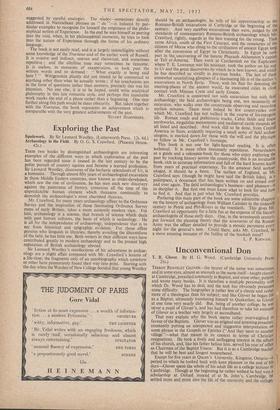Exploring the Past
THESE two books by distinguished archaeologists are interesting examples of the ,different ways in which exploration of the past has been regarded since it ceased in the last century to be the polite pursuit of country squires and became a learned profession. Sir Leonard Woolley, discoverer of the barbaric splendours of Ur, is a humanist. Through almost fifty years of archaeological excavation in those Middle Eastern countries, now known as under-developed, which saw the rise of civilisation, he has seen each new discovery against the panorama of history, conscious all the time of the unpredictable human element which threatens continually to demolish the archaeologist's most cherished theories.
Mr. Crawford, for many years archaeology officer to the Ordnance Survey and the inspiration_ of those fascinating Ordnance Survey maps of early Britain, takes a more austerely modern view. For him, archaeology is a science, that branch of science which deals with past human cultures, the basis of which is technology. He is all for the independence of archaeology, independence that is to say from historical and epigraphic evidence. For those effete persons who languish in libraries, thereby avoiding the discomforts of the field, he has little use. Both writers in their different ways have contributed greatly to modern archaeology and to the present high reputation of British archaeology abroad.
Sir Leonard Woolley's recollections of his adventures in archae- ology are a slight affair compared with Mr. CrawfOrd's lessons of a life-time; the fragments only of an autobiography which somehow or other have prematurely found their way into print. Starting with the day when the Warden of New College decided that young Woolley should be an archaeologist, he tells of his apprenticeship to the Romano-British excavations at Corbridge at the beginning of the century. And very carefree excavations they were, judged by the standards of contemporary Romano-British archaeology which Mr. Crawford, rightly, regards as the best training for the young. Then came Africa, south of the First Cataract, and the cemeteries of the citizens of Meroe who clung to the civilisation of ancient Egypt long after the conversion of Egypt to Christianity. In Egypt he took part in the, uncovering of the heretic Pharaoh Akhenaton's capital at Tell el-Amama. Then work at Carchemish on the Euphrates, where T. E. Lawrence was his assistant, took the author on his waY to Ur and the great discoveries by which he is best known, and which he has described so vividly in previous books. The last of these somewhat unsatisfying glimpses of a fascinating life is of the author's excavations in North Syria. There, with his flair for detecting the meeting-placeS of the ancient world, he excavated cities in close contact with Minoan Crete and early Greece. Mr. Crawford is concerned not with excavation but with field archaeology; the field archaeologist being one, not necessarily an excavator, who walks over the countryside observing and recording surface remains. There must indeed be few countrysides over which Mr. Crawford has not walked in the course of his energetic life. Roman roads and prehistoric tracks, Celtic fields and linear earthworks, megalithic monuments and mediaeval castle mounds are all listed and described. And work still to be done, from Central America to Siam, evidently requiring a small army of field archae- ologists, is marked down for those with the`will and the physique to follow in Mr. Crawford's footsteps.
This book is not one forlight-hearted reading. It is often technical. It is more often tiresomely repetitious. Nevertheless, as a guide and a reference-book for those who enjoy exploring the past by tracking history across the countryside, this is an invaluable book, rich in accurate information and full of the hard lessons learnt from years of practical experience. To the amateur field archae- ologist, it should be a boon. The surface of England, as Mr. Crawford says (though he might have said the British Isles), is a palimpsest, a document that has been written on and erased over and over again. The field archaeologist's business—and pleasure—IS to decipher it. But first one must know what to look for and host to find it. And that is just what Mr. Crawford provides. Prefacing this main part of the book are some admirable chapters on the history of archaeology from William Camden in the sixteenth century to Petrie and Pitt-Rivers in the twentieth. This gives Mr. Crawford an opportunity for a little fun at the expense of the literary archaeologists of those early days. ,One, in the seventeenth century, put forward the pleasing theory that the tesserarius of the Roman Army was the officer detailed to provide a mosaic pavement every night for the general's tent. Could there, asks Mr. Crawford, be a more amusing instance of the futility of the bookish mind?
L. P. KIRWAN.


































 Previous page
Previous page